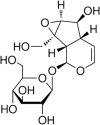Recent advances in the multifaceted mechanisms of catalpol in treating osteoporosis
- PMID: 40103589
- PMCID: PMC11913683
- DOI: 10.3389/fphar.2025.1560715
Recent advances in the multifaceted mechanisms of catalpol in treating osteoporosis
Abstract
Catalpol (CAT) is a landmark active ingredient in traditional Chinese medicine Rehmannia (TCT), also known as dehydroxybenzoate catalpone, which is a kind of iridoid terpene glycoside with strong antioxidant, anti-inflammatory, antitumor and other biological activities. It can exert its anti-disease effect in a variety of ways. For some patients with chronic diseases, the application of azalea alcohol in rehmannia may bring more comprehensive and long-lasting efficacy. Studies have shown that the anti-disease effect of catalpol in osteoporosis (OP) is mainly achieved through various pathways such as Wnt/β-catenin signaling pathways to promote osteogenic differentiation, and RANKL/RANK and other signaling pathways to inhibit osteoclastic differentiation. At present, there is a slight lack of analysis of the mechanism of action of catalpa alcohol in the treatment of osteoporosis, so this study comprehensively searched the literature on the mechanism of action of catalpa alcohol in the treatment of osteoporosis in various databases, and reviewed the research progress of its role and mechanism, to provide reference and theoretical basis for the further development and application of catalpol.
Keywords: catalpol; osteoclasts; osteogenesis; osteoporosis; pharmacological mechanisms.
Copyright © 2025 Li, Mu, Zhang and Wang.
Conflict of interest statement
The authors declare that the research was conducted in the absence of any commercial or financial relationships that could be construed as a potential conflict of interest.
Figures




Similar articles
-
Catalpol attenuates osteoporosis in ovariectomized rats through promoting osteoclast apoptosis via the Sirt6-ERα-FasL axis.Phytomedicine. 2024 Jan;123:155262. doi: 10.1016/j.phymed.2023.155262. Epub 2023 Dec 5. Phytomedicine. 2024. PMID: 38100921
-
Catalpol suppresses osteoclastogenesis and attenuates osteoclast-derived bone resorption by modulating PTEN activity.Biochem Pharmacol. 2020 Jan;171:113715. doi: 10.1016/j.bcp.2019.113715. Epub 2019 Nov 18. Biochem Pharmacol. 2020. PMID: 31751538
-
Catalpol promotes the osteogenic differentiation of bone marrow mesenchymal stem cells via the Wnt/β-catenin pathway.Stem Cell Res Ther. 2019 Jan 22;10(1):37. doi: 10.1186/s13287-019-1143-y. Stem Cell Res Ther. 2019. PMID: 30670092 Free PMC article.
-
Multifaceted therapeutic potentials of catalpol, an iridoid glycoside: an updated comprehensive review.Inflammopharmacology. 2025 Mar 17. doi: 10.1007/s10787-025-01694-1. Online ahead of print. Inflammopharmacology. 2025. PMID: 40097877 Review.
-
Research Progress on Catalpol as Treatment for Atherosclerosis.Front Pharmacol. 2021 Jul 13;12:716125. doi: 10.3389/fphar.2021.716125. eCollection 2021. Front Pharmacol. 2021. PMID: 34326774 Free PMC article. Review.
Cited by
-
The Protective Activity of Apigenin Against Bone and Cartilage Diseases.Clin Interv Aging. 2025 Aug 13;20:1235-1251. doi: 10.2147/CIA.S529148. eCollection 2025. Clin Interv Aging. 2025. PMID: 40827276 Free PMC article. Review.
References
-
- Ajizian S. J., English B. K., Meals E. A. (1999). Specific inhibitors of p38 and extracellular signal-regulated kinase mitogen-activated protein kinase pathways block inducible nitric oxide synthase and tumor necrosis factor accumulation in murine macrophages stimulated with lipopolysaccharide and interferon-gamma. J. Infect. Dis. 179 (4), 939–944. 10.1086/314659 - DOI - PubMed
-
- Ayers C., Kansagara D., Lazur B., Fu R., Kwon A., Harrod C. (2023). Effectiveness and safety of treatments to prevent fractures in people with low bone mass or primary osteoporosis: a living systematic review and network meta-analysis for the American college of physicians. Ann. Intern. Med. 176 (2), 182–195. 10.7326/M22-0684 - DOI - PubMed
Publication types
LinkOut - more resources
Full Text Sources
Miscellaneous

